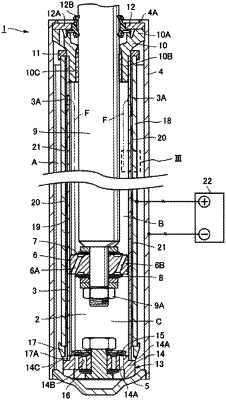| CPC F16F 9/532 (2013.01) [F16F 9/185 (2013.01); B60G 13/08 (2013.01); B60G 17/08 (2013.01); B60G 2202/24 (2013.01); B60G 2204/62 (2013.01); B60G 2206/41 (2013.01); B60G 2206/70 (2013.01); B60G 2500/104 (2013.01); B60G 2600/182 (2013.01); B60G 2600/73 (2013.01); B60G 2800/162 (2013.01); F16F 9/3235 (2013.01); F16F 2222/06 (2013.01); F16F 2222/12 (2013.01); F16F 2224/02 (2013.01); F16F 2224/043 (2013.01); F16F 2228/007 (2013.01); F16F 2228/066 (2013.01); F16F 2230/18 (2013.01); F16F 2230/48 (2013.01); F16F 2232/08 (2013.01); F16F 2234/02 (2013.01)] | 11 Claims |

|
1. A damper device comprising:
a piston rod;
an outer tube housing the piston rod;
an electro-rheological fluid provided between the outer tube and the piston rod; and
a voltage applying mechanism that is provided between the outer tube and the piston rod and applies a voltage to the electro-rheological fluid,
wherein
the voltage applying mechanism includes an anode and a cathode,
the electro-rheological fluid is located between the anode and the cathode,
an insulating layer is provided on a surface of the anode on a side facing the cathode or on a surface of the cathode on a side facing the anode, and
a thickness t (m) of the insulating layer satisfies following Formula (1) when a maximum voltage applied to the electro-rheological fluid is Vmax (V),
t≥2.5×10−8×Vmax Formula (1)
|